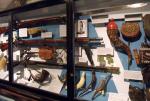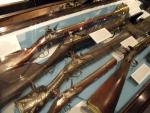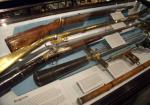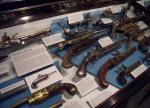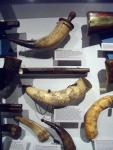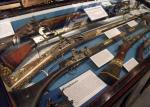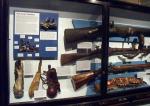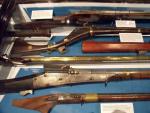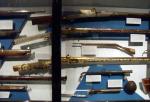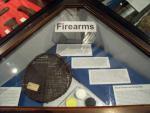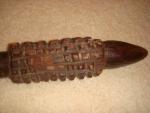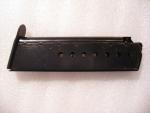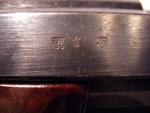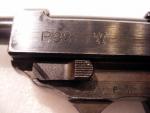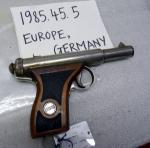
helen
For Deletion-
Posts
166 -
Joined
-
Last visited
Content Type
Profiles
Forums
Blogs
Gallery
Events
Store
Everything posted by helen
-
-
-
-
-
-
-
Hello all, Just to let those of you in the South England vicinity know that the new permanent firearms display at the Pitt Rivers Museum in Oxford is now open to the public. The display features over 300 objects from a first millennium 'Greek fire' bomb to late C20th automatic weapons. I will take some photos to put up here soon! Thanks, Helen
-
Britain's Greatest Machines
helen replied to seanschmolz's topic in Great Britain: Research, Documentation & History
Hi Sean, the Gatling was certainly American but i think Maxim did develop/patent his machine gun in England after he emigrated from the US in 1881 (although he himself didn't become a British citizen until later). The company/factory Maxim founded to produce his gun was at 57 Hatton Garden, London and is commemorated with a plaque. Others may have suggestions in terms of larger weapons/artillery etc but small arms are all I know anything about I'm afraid! Best, Helen -
Britain's Greatest Machines
helen replied to seanschmolz's topic in Great Britain: Research, Documentation & History
I would go for... Maxim machine gun 1884 - world's first automatic (recoil-operated) weapon, heralded the concept of 'industrialized warfare'. Machine guns had existed before this (i.e. Gatling/Gardner) but these had been hand-operated. Hiram Maxim was born in American but adopted British citizenship. Maxim gun used to aid British colonial efforts in Africa 1884-1914, including Rhodesia (where just 4 guns helped 50 British defeat 5000 natives), Sudan and the Boer War in South Africa. Failing that, I'd say the Brown Bess (Land Pattern Musket) must be a high-profile candiate - the British Army's standard musket which was the first firearm to be made according to a standardized pattern which made the supply of ammo, repair parts, etc much easier. She was in use for over a century (from 1722 to about 1840 - and beyond in some colonial arenas) and was as much a symbol of Empire as anything else I can think of. Esp in reference to the British in India - a special (lighter and shorter) version of the gun was made for the troops attached to the East India Company and would later be adopted as the standard version by the Army in the 1790s - was an effective weapon (along with the Baker Rifle) for Britain during the Napoleonic Wars. Sounds like an interesting project - good luck! Helen -
Belgian Revolver ID .. (and what I found so far)
helen replied to nazfrank's topic in Firearms & Ordnance
Interesting weapon. Seems a letter with the star above it denotes a named person who was the controller/inspector of the proof (See here, bottom of page) . However, your back to front letter doesn't figure and the dates appear too late. Helen -
Hello, Sorry I didn't see this item earlier so thanks to Mervyn for bringing it to my attention - very intriguing! We don't tend to have much in the way of artillery at our Museum but in any case, I have never heard of or seen a bronze cannon ball or naval gun ball. I'm pretty sure American 6-pounder field guns of the 1770s would have fired solid iron balls. The fact that it's hollow suggests a stronger possibility of it being a mortar shell as others have suggested - maybe of the type used by the French at Yorktown? - or even an explosive carcass, although again, these tended to be of iron or even canvas and had more than one hole to let the flames out. My other thought was that it may not be anything to do with warfare at all and might be one of those gate-shutter weights of times past, the hole where the hook would have been?! Sorry not to be of more help but will be interesting to see if anyone gets to the bottom of this! Helen
-
Rather off-topic, but speaking of things naval, I went to look round HMS Belfast last weekend. I did not realise that it was commonplace to invert the ship's bell and use it as a font in the chapel to baptize infants born to seamen! I wonder how old that practice is/was? Nice close-up pictures by the way. H
-
A valid point Mervyn...we have many many bayonets in the museum but they are all in storage. I am hoping one day they will see the light in the form of display! Your sword is is very good condition - what is the lozenge-like shape on the tip of the scabbard? Don't think I've seen that before - just for aesthetics or any practical use?
-
Mervyn, Thanks so much for replying so quickly and for the wealth of information about the club - I shall pass your observations on to our enquirer and of course tell her where they came from! As for marriage - yes, it is a lovely state of being and I am thoroughly enjoying it. As for the truncheons - I know, I know - I'm sorry! I haven't forgotten about them. To be honest, part of the reason I haven't attended to the matter earlier is my unfortunate feeling that we won't have much in the way of what you're looking for. But nevertheless, I will have a look in the next few weeks. The firearms project is nearly at a close so things should quieten down I hope! All the best, Helen
-
hi Mervyn, Interesting stuff about the Zulu courtship practices! I have something you may be able to help with. We had an email from someone with some photos of a wooden club she has in her possession. She said she believed it to be a Zulu knobkerrie and to date to the time of the Zulu wars. She didn't say how she acquired it nor how big it is. We couldn't find much comparable in our collections. These are the only (not great) photos she sent - can you shed any light on it, at least whether you believe it to be Zulu or not? Many thanks, Helen
-
hi, No, I don't think so - that must be another one! 'Arithmetic...' talks about how the expensive training and education bestowed upon British troops amounts to little when faced with guerilla warfare they can do little to cope with: "A scrimmage in a Border Station -- A canter down some dark defile -- Two thousand pounds of education Drops to a ten-rupee jezail -- The Crammer's boast, the Squadron's pride, Shot like a rabbit in a hide!" Helen
-
Dan - thanks very much for the links - really helpful! Mervyn - yes, we have a couple of air guns. None of the copper ball type but the ones with a detachable butt reservoir along the Girandoni lines. One of these is made entirely of brass and there's also a late C18th-early C19th one made by Durs Egg, gunmaker to the king. We also have a walking stick gun, the type that gained popularity after the carrying of swords on the street became frowned upon after the Revolutionary Wars. I will post photos soon! Helen
-
hi, Here is our Mauser-made P38 byf 43 that is going on display in the Museum. Apparently the serial number (190P) suggests it was actually made in early 44 rather than 43. Sadly rather inferior photos and no beautiful holster such as yours has Douglas, nor an interesting lanyard like Nesredep's! Helen
-
hello Gentlemen, This is an air pistol by C. G. Haenel, according to the markings, a Model 100 DRP (Deutsche Reich Patent), c. 1925-1940? It has the number 1837 on the underside of the grip. It was handed into the police as part of a weapons amnesty in the 1980s so no personal history. All I've found out about it is that the Haenel Co was based in Suhl, Germany. I can't find much in what limited books I have about air guns and all web searches seem to being up only the Haenel Model 28 (.177 cal). If anyone knows anything about this model of gun, its use (law enforcement? Military training?), or about the Haenel Co in general, I'd be very grateful if you could point me in the right direction. Thanks, Helen
-
Not what you're looking for, but Rudyard Kipling's poem, 'Arithmetic on the Frontier' is worth including in any reading of the Anglo-Afghan wars.


